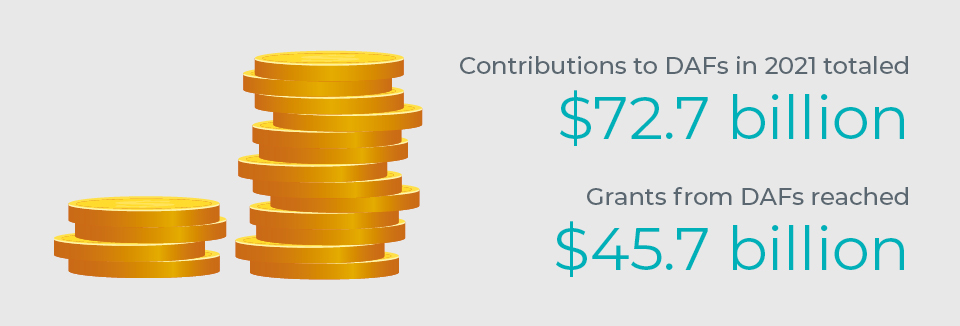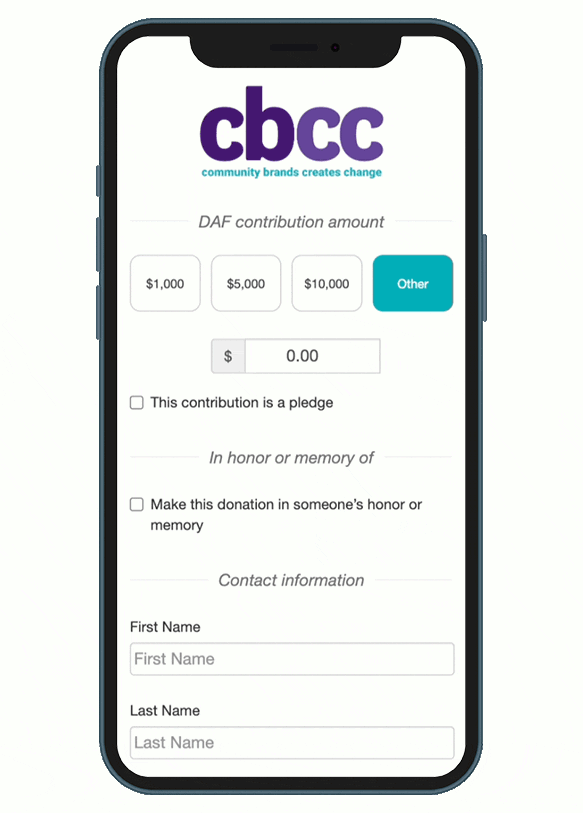May 30, 2023
The Need-to-Know on Donor Advised Funds (DAFs)

Donor-advised funds (DAFs) are one of the fastest-growing categories of charitable contributions, with DAF giving increasing over 400% over the last decade. Most of this exponential growth happened in the past few years.
Donor-advised funds offer the potential for nonprofits to expand their revenue and diversify giving streams as well as bring stability to an organization.

With contributions to DAFs at an all-time high, and grants from DAFs to charitable organizations reaching a reciprocal all-time high, it is time to educate yourself on DAFs and learn how your organization can secure donations from these billion-dollar entities.
What is a Donor-Advised Fund (DAF)?
A DAF is an investment account, where the sole beneficiaries are nonprofit organizations. Donors contribute to the account, those contributions are invested, the assets grow tax-free, and the DAF manager grants funds to chosen nonprofit organizations from the fund.
DAFs are funded by individuals, families, trusts, estates, and groups, such as associations or workplace giving.
Funding to a DAF comes in the form of cash, wire transfer, check, stocks, securities, mutual funds, real estate, cryptocurrency, and more. For any investment it applies to, capital gains taxes don’t apply because the sole beneficiaries are nonprofits, that by design do not pay taxes.
There are benefits and other things to consider for donors and nonprofits when working with DAFs.
Pros and Cons of Donor-Advised Funds (DAFs)
DAFs offer a lot of potential for nonprofits to grow, stabilize, and diversify revenue. Donors get immediate tax benefits and bypass capital gains taxes. But some parameters around DAFs may price out potential donors and limit their control of how and when grants are given.
Additionally, DAFs’ funding is exponentially outpacing DAFs’ grant-making. They are investment accounts, which by design are meant to grow over time. Therefore, donors’ contributions are granted over time, which might feel disadvantageous to nonprofits.
Pros
DAF Pros for Donors
- Immediate tax benefit
- Money grows tax-free
- Varied ways to give (stock, cash, cryptocurrency, etc.)
- Can give anonymously
- Avenue for legacy planning
DAF Pros for Nonprofits
- Unrestricted gifts
- No transaction fees
- No formal reporting and limited administrative burden
- Higher giving total over time
A DAF is beneficial to donors, as they receive an immediate tax deduction for their contribution, even though that money doesn’t immediately go to a charity. Donors can request how and when funds are distributed, give anonymously, name successors, and use a DAF to establish legacy giving.
DAFs grow tax-free, so while gifting is delayed, the overall total of a contribution should be higher than if a donor gave directly to a nonprofit. Most DAF gifts are unrestricted, so nonprofit organizations have more discretion on how to use them, as opposed to grants from foundations or designated gifts. Furthermore, unlike foundations, DAFs do not require formal reporting. Any fees on a DAF are paid by the donor, not the recipient. The administrative burden is far less for a nonprofit organization when accounting for DAFs.
Cons
DAF Cons for Donors
- High start-up cost
- Funds cannot be used for donor benefits (tickets, scholarships, etc.)
- Limited control on grant-making
DAF Cons for Nonprofits
- Limited access to donor information
- Delayed gifting
While donors can contribute as often as they want, most DAFs require a substantial startup contribution, with many starting at around $25,000. All donations to a DAF are irrevocable, so under no circumstances can they be returned to the donor, unlike other investment accounts.
Grants from a DAF cannot be used for anything that benefits the donor, such as tickets, tuition, memberships, or auction items, so using DAF grants for sponsorships is not possible in most instances. Most DAF grants are unrestricted, which could limit interest from donors. Furthermore, if a charity is less than five years old, DAFs scrutinize its validity before making any gifts.
For nonprofits, DAFs’ grants can be made anonymously, and personal information is more guarded, making donor retention hard to measure and stewardship perhaps impossible. As previously mentioned, DAFs have no required distribution requirements, so intended money is ultimately at the discretion of DAF managers. While donors can advise on grant making, the process is the ultimate decision of the DAF manager or sponsor, so donor control is possibly limited.
How Can a Donor-Advised Fund (DAF) Impact Your Organization?
Even though there are some limits on DAFs, nonprofit organizations should absolutely solicit grants from DAFs and inquire with donors who use DAFs as an avenue for giving.
The money grows over time, so in periods of economic instability or after a donor retires or transfers control to their family, DAF giving can remain consistent and stable because the irrevocable fund is already established.
3 ways to secure donations or grants from DAFs
1. Educate donors on how a DAF can have an immediate impact on your organization
A great way to explore DAFs with your donors is to educate them on how a DAF can have an immediate impact on your organization. This involves targeted storytelling and relationship building via donor segmentation. Ask them if they have a DAF, plan to establish one, or if they know what a DAF is; you can identify areas for education and growth and areas for nurturing relationships with donors who have established DAFs.
You should also incorporate language about DAFs into your existing marketing tactics, such as emails, social media, and direct snail mail.
2. Provide easy opportunities for DAFs to give to your organization
Include a page on your organization’s website to promote DAFs and how you can work together with donors that have DAFs. Create a DAF-specific giving form, making it very easy to pledge from a DAF to your organization, and make sure to include a question asking donors if they have a DAF fund so you can better identify those potential opportunities.
GiveSmart Fundraise provides these opportunities for all organizations with unlimited, customizable forms with features like dropdowns, check boxes, and more for all users.
If you have received a grant from a DAF that is tied to a known donor, who already, separately paid for a ticketed event, consider allowing them to participate in the paddle raise, for recognition, for the already confirmed and received gift. While donors cannot get any benefit with tangible associated costs, such as a sponsor advertisement, ticket, or VIP access, anything around unrestricted giving, such as a paddle raise, is an excellent stewardship opportunity.
 |
Don’t forget to reach out to and build relationships with DAF managers or sponsors. Some DAFs have an online portal for donors to recommend contributions, so you’ll want to ensure your organization can be easily found and that your information is up-to-date and accurate. Some DAFs use charity research platforms like GuideStar to research nonprofits, so make sure those are up to date, too.
Top 10 DAFs by Assets
- Fidelity Charitable Gift Fund
- Schwab Charitable Fund
- Silicon Valley Community Foundation
- National Philanthropic Trust
- Vanguard Charitable Endowment Program
- Goldman Sachs Philanthropy Fund
- American Endowment Foundation
- National Christian Foundation
- Morgan Stanley Global Impact Fund
- Bank of America Charitable Gift Fund
- Source: The Institute for Policy Studies (ISP) as of 2020
3. Thank DAFs and Donors
Make sure to send thank yous to both the DAF donor (if the gift was not made anonymously) AND the DAF manager, separately. While the check or contribution comes directly from the DAF, the contribution itself was recommended by the donor.
If you have the information, steward donors who gave via DAF to keep those contributions coming in, and also steward relationships with potential legacy donors or donors you have identified that have DAFs.
Learn more about GiveSmart! Enjoy one contract, one payment, and one vendor partner for year-round fundraising and donor management success, including recording DAF contributions.
Request a personalized demo of the GiveSmart suite or contact us today for more information on plans and pricing.
Every effort was made to source up-to-date information on DAFs, but GiveSmart does not advise on accounting or taxes. This blog serves as an informational resource, so make sure to consult financial professionals to verify any plans and strategies you have for soliciting and accounting for DAFs.
Related



